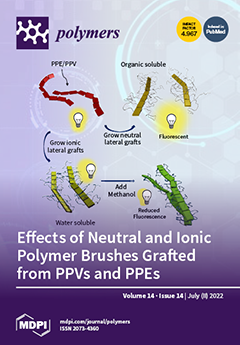Meltblown (MB) nonwovens as air filter materials have played an important role in protecting people from microbe infection in the COVID-19 pandemic. As the pandemic enters the third year in this current global event, it becomes more and more beneficial to develop more
[...] Read more.
Meltblown (MB) nonwovens as air filter materials have played an important role in protecting people from microbe infection in the COVID-19 pandemic. As the pandemic enters the third year in this current global event, it becomes more and more beneficial to develop more functional MB nonwovens with special surface selectivity as well as antibacterial activities. In this article, an antibacterial polypropylene MB nonwoven doped with nano silicon nitride (Si
3N
4), one of ceramic materials, was developed. With the introduction of Si
3N
4, both the average diameter of the fibers and the pore diameter and porosity of the nonwovens can be tailored. Moreover, the nonwovens having a single-side moisture transportation, which would be more comfortable in use for respirators or masks, was designed by imparting a hydrophobicity gradient through the single-side superhydrophobic finishing of reactive organic/inorganic silicon coprecipitation in situ. After a nano/micro structural SiO
2 precipitation on one side of the fabric surfaces, the contact angles were up to 161.7° from 141.0° originally. The nonwovens were evaluated on antibacterial activity, the result of which indicated that they had a high antibacterial activity when the dosage of Si
3N
4 was 0.6 wt%. The bacteriostatic rate against
E. coli and
S. aureus was up to over 96%. Due to the nontoxicity and excellent antibacterial activity of Si
3N
4, this MB nonwovens are promising as a high-efficiency air filter material, particularly during the pandemic.
Full article






